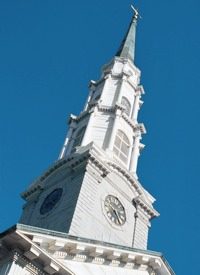
The case involves the Hosanna-Tabor Evangelical Lutheran Church and School of Redford, Michigan, which in 1999 signed a one-year contract with Cheryl Perich to teach fourth grade at the church school. As well as teaching secular subjects, she taught religious subjects and was a lay minister of the church. In 2004, Perich developed the sleep disorder narcolepsy, which in the eyes of church and school officials made her unable to continue teaching, and she was terminated.
As reported here, Perich complained to the Equal Employment Opportunity Commission, which in turn has alleged that she was fired in violation of the Americans with Disabilities Act. The case was dismissed by the federal district court in Michigan in which the action was filed, with the judge citing the “ministerial exception” in that federal law, which is intended to prevent the federal government from interfering with church affairs. The federal appellate court, however, reversed that ruling.
Various groups have taken sides in the lawsuit. The U.S. Conference of Catholic Bishops, the Mormon Church, and the Union of Orthodox Jewish Congregations have all filed amicus briefs in support of the school’s right to terminate Perich.
Terrence Jeffrey notes that those organizations that have filed briefs against the school were Americans United for Separation of Church and State, and American Atheists. The U.S. Department of Justice has also weighed in on the side of Perich. In oral arguments before the Supreme Court, Acting Deputy Solicitor General Leondra Kruger contended that the federal government should be able to override church decisions in such cases:
Their [the Hosanna-Tabor Church and School’s] submission is that the hiring and firing decisions with respect to parochial school teachers and with respect to priests is categorically off limits, and we think that that is a rule that is insufficiently attentive to the relative public and private interests at stake, interests that this court has repeatedly recognized are important in determining freedom of association claims.
Freedom of association is not explicitly mentioned in the Constitution; it has developed as an appendage of the First Amendment’s freedom of speech rights. The implication of this sort of assertion is more serious than it appears on the surface. Historically, congregations have reserved an absolute right to determine who may and may not belong to a church or synagogue.
Moreover, in religious schools there have historically been certain requirements that extend beyond civil law stipulations and that may necessitate a priest, rabbi, or lay minister. Religious schools are all voluntary.
Churches and synagogues, along with their schools and daycare facilities, are intended to be free in their rules and beliefs, which may run contrary to what the federal government wishes. The involvement of the Department of Justice in the Perich case brings into question whether the congregants and officials of a religious institution may preserve their own freedom of association.
The Lutheran church has stressed that its doctrine, in accord with that of most Christian churches, is to resolve all disagreements peacefully within the church. The Hosanna-Tabor Lutheran church and school has a method of conflict resolution for resolving disagreements with “called” employees (those who, like Perich, have said that they felt called to their position in the church). The congregation had voted to ask Perich for a “peaceful release from her call” — an act whereby the congregation and a minister agree to release one another from the mutual obligations that the call entailed. There is no disapprobation attached to this sort of release, and the lay minister may be called again at a later time. Perich, however, declined the “peaceful release” and also, according to the school principal, the use of the dispute resolution policy of the church.
Terrence Jeffrey of CNSNews concludes his article on the Supreme Court case as follows: “What is at stake is the First Amendment and the religious freedom of all Americans.”



